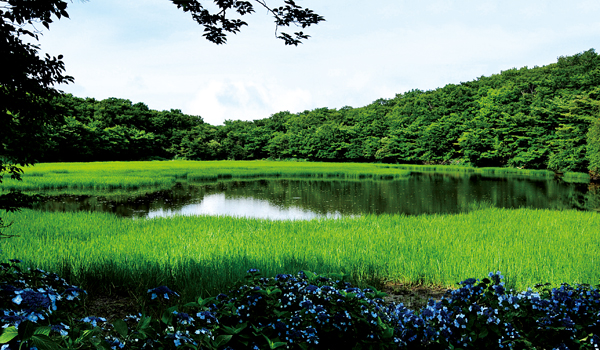| |
 |
|
| The giant water bug and narrow-mouth frog can be found at Mulyeongari Oreum, north of Pyoseon. Photo courtesy Jeju Tourism Organization |
Few are likely to have noticed the passing of World Wetlands Day in early February. This annual celebration of all things semi-aquatic dates back to 1971, when the Convention on Wetlands (the Ramsar Convention) was signed in Ramsar, Iran. There is no need to be distraught about missing the celebrations, however, as Jeju boasts some world-class wetland habitats for year-round pleasure.
When governments sign up to the Ramsar Convention, as over 150 have so far, they express a commitment to maintaining crucial national wetlands. These commitments come with a blast of sustainability jargon, best summarised as “wise use”.
“Wise use” is an approach to natural resources, human expertise, tourist services, and so on, which allows nature to live and breath as it would undisturbed. In Korea, this has led to something of a political quagmire.
Wetlands globally cover an area one third larger than the U.S.A, yet there is no clear definition of what a wetland is. The convention itself is ambitiously broad in scope, including marsh, fen, peatland, and shallow tidal zones. These environments tend to be hugely diverse and, due to waterfowl migrationary habits, form a transnational network that requires an equally transnational response.
Since acceding to the Ramsar Convention in 1997, the South Korean government has accrued 18 designated Ramsar sites, four of which are found on Jeju. Two of these are found on oreum (parasitic cones), which themselves were created by the interaction of land and water.
In the aeons of Jeju’s formation, when magma would frequently surge to the surface, explosive contact of surface water and molten material eventually generated the unique, rolling, landscape that we see today. It seems appropriate then that oreum now play host to such important wetland ecologies.
Signees to the convention commit to “combining far-sighted national policies with coordinated international action” for the purpose of protecting the kind of flora and fauna that flourish in wetland environments.
Far-sighted national policies often seem to point in different directions in Korea. The government and its agencies frequently boast of a green push toward sustainable management of natural habitats; it is, however, impossible not to notice the rampant pace of commercial and infrastructure development.
These strike like a faultline through wetland conservation, as they do through all issues concerning Korea’s environment. Conservation groups criticized the previous government’s “Four Rivers Project” for its roughshod treatment of Korea’s wetland habitats, which resulted in it being put in the top five worst wetlands-related projects by the Ramsar Committee in 2012.
The Ramsar Convention has been seen by environmental groups as a major step forward. It is not, however, a legally binding or restrictive agreement - there are no penalties for failing to honour the agreement. While for the time being Jeju’s Ramsar sites survive, much of Korea’s wetlands are under threat in the absence of strong national laws protecting them. In the struggle for these, the Ramsar Convention is likely to be little more than a symbolic reference.
| |
 |
|
| Closely associated with Grandmother Seolmundae, Muljangori is a crater lake. Photo by Shin Yong-man |
Mulyeongari Oreum
Mulyeongari Oreum was listed because of the grassy crater lake at its crown. Though small and as shallow as one meter during dry spells, it is is home to a pair of endangered species: the giant water bug and the narrow-mouth frog. Found on road 1118 north of Pyoseon, the oreum can be accessed via a walkway that runs to its top.
Muljangori Oreum
Muljangori Oreum, added in 2008, is also a crater lake, located 900m above sea level. In local lore the Muljangori oreum has strong associations with Grandmother Seolmundae, Jeju’s creator goddess. The 63-hectare site is currently off-limits for trekkers.
The 1100 Altitude Wetland
The highest on the list, the 1100 Altitude Wetland was added in 2009. It is really an assortment of half a dozen or so wetlands, phasing in and out of existence subject to rainwater and seepage. Among the most beautiful of Jeju’s wetlands, it is also one of the most ecologically crucial because of the volume of water that it holds. Visitors, well served by wooden walkways and viewing platforms, have a chance of spotting Siberian Roe Deer and the Eurasian Badger.
Dongbaekdongsan
Dongbaekdongsan, the latest addition, is located in one of Jeju’s enchanting evergreen forests, the north-eastern Seonheul Gotjawal. You will not find surface water in most Gotjawal and, despite its Ramsar status, there is little to be found on Dongbaekdongsan itself. The volcanic bedrock acts as a geological sieve, allowing rain to run down to the water table. For this reason, Dongbaek-dongsan feeds the groundwater used as a source for the half-million residents of Jeju Island. There are, however, some streams and ponds in the area, breeding grounds for such species as the Black Paradise Flycatcher.
|





















